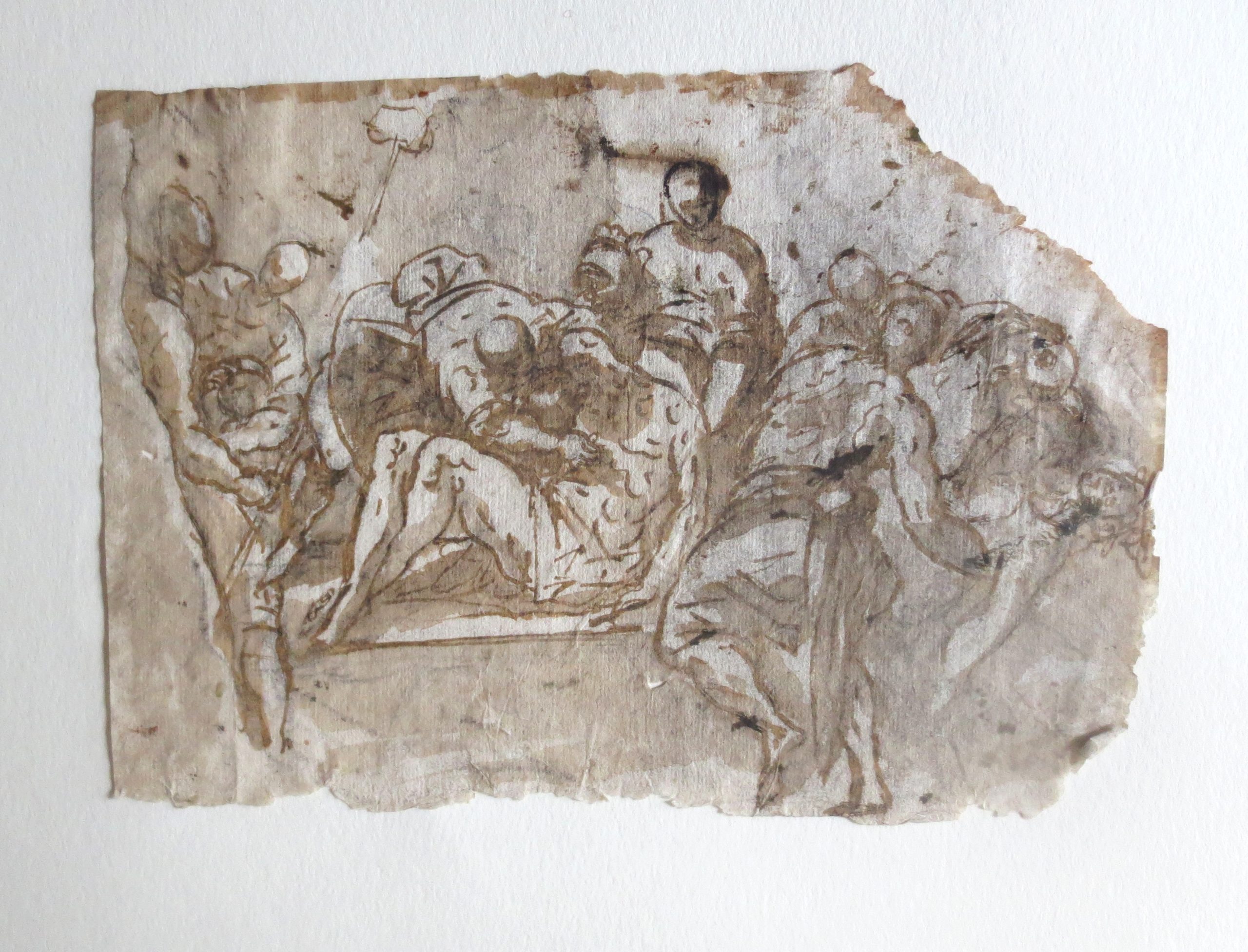Inscribed on verso ‘Jiacomo Tintoretto’ either in Mariette’s minuscule script (cf. Lugt, Marques, No. 1998) or a similar script belonging to the nineteenth century Italian collector L. Grassi (Lugt 1095). More recently, the drawing was acquired in the 1960s by the collector-dealer Helene Seiferheld following the advice of Leo Steinberg.
The old attribution to the elder Tintoretto seems plausible enough for a drawing probably done early in his career. As a lamentation over Christ’s body after removal from the Cross, it follows in variation a compositional formula which by narrative iconographic necessity remained fairly consistent from late Byzantine art and through the Italian Renaissance in well known examples by Raphael, Titian and in particular bronze reliefs by Andrea Riccio (Kress collection, Washington, D.C.). As in the Riccio version in the Kress collection, this drawing shows the Lamentation at the translation of Christ’s body on the Stone of Unction, thus inaugurating the altar as the anointed place for the elevation and translation of the host.
The technique and style of this drawing are consonant with Tintoretto’s hand: the large forms of the body, some as the exaggerated bulk of the thigh and the free floating scoops that seemingly chart protruding muscles, are all drawn with a wide nibbed reed pen in a dark brown ink, perhaps bistre but not acidic iron gall, and then surrounded or swamped by brushed washes of a bistre tint that tones most of the full page warm beige and so sets up the focal highlights of light paper reserves.
All of these elements from anatomical types to handling of pen and brush to the early inscription support the traditional attribution of this sheet to Tintoretto’s early maturity. A strong impression of a creative exploration by an emergent master is further supported by the intriguing figure running inward from the far right of the scene. This figure and its action partially reflect in reverse a drawing of a running man by Tintoretto formerly in the collection of Frank Jewett Mather when published in H.Tietze and E.Tietze-Conrat, The Drawings of the Venetian Painters of the Fifteenth and Sixteenth Centuries, New York, 1944, No.1604.
For Tintoretto’s use of small wax figurines as models that could be drawn from any angle, and with that his frequent reversal of drawn figures in accordance with narrative needs, cf. the still useful Detlev Freiherr von Hadeln, Handzeichnungen des Giacomo Tintoretto, Berlin,1922, pp. 41-44). While at first glance the running figure might prove a confusing party to the scene, his presence opens a more instructive potential as one of the two bearers laying Christ on the stone of unction, his limp arm marking the transmission of the eucharist from this altar.
Within the drawing a second compositional experiment overlaps essential space. Finally, small differences in figure proportions and variance in the abbreviated strokes of the pen and placement of shadow passages between somewhat timid and fully assured handling might well be seen as a drawn détente between invention and emulation, an issue now opened by a particularly astute reconstitution of El Greco’s emergence as an inchoate artistic persona in Tintoretto’s studio of the late 1560s.
For an invaluable re-reckoning of the entire matter in conjunction with the epochal Tintoretto exhibition at the Morgen Library, cf. John Marciari, Drawing in Tintoretto’s Venice, New York, 2018, “The Drawings of the Young El Greco in Italy”, pp.167-183. This was followed by a reflective review of much of the fundamental discussion of drawing as practiced by Tintoretto and his circle by John Marciari, “Drawing in Tintoretto’s Venice: Marginal Notes to an Exhibition“, Artibus et Historiae, Cracow, 2020, pp. 237-252.

